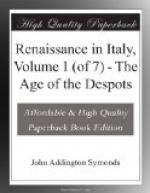Feltre, Beliuno, Conegliano, and Romano, the very nests
of the grim brood of Ezzelino, yielded to the charm.
Verona, where the Scalas were about to reign, Vicenza,
Mantua, and Brescia, all placed themselves at the
disposition of the monk, and prayed him to reform their
constitution. But it was not enough to restore
peace to each separate community, to reconcile household
with household, and to efface the miseries of civil
discord. John of Vicenza aimed at consolidating
the Lombard cities in one common bond. For this
purpose he bade the burghers of all the towns where
he had preached to meet him on the plain of Paquara,
in the country of Verona. The 28th of August was
the day fixed for this great national assembly.
More than four hundred thousand persons, according
to the computation of Parisio di Cereta, appeared
upon the scene. This multitude included the populations
of Verona, Mantua, Brescia, Padua, and Vicenza, marshaled
under their several standards, together with contingents
furnished by Ferrara, Modena, Reggio, Parma, and Bologna.
Nor was the assembly confined to the common folk.
The bishops of these flourishing cities, the haughty
Marquis of Este, the fierce lord of Romano, and the
Patriarch of Aquileia, obeyed the invitation of the
friar. There, on the banks of the Adige, and
within sight of the Alps, John of Vicenza ascended
a pulpit that had been prepared for him, and preached
a sermon on the text, Pacem meam do vobis, pacem
relinquo vobis. The horrors of war, and the
Christian duty of reconciliation, formed the subject
of his sermon, at the end of which he constrained
the Lombards to ratify a solemn league of amity, vowing
to eternal perdition all who should venture to break
the same, and imprecating curses on their crops, their
vines, their cattle, and everything they had.
Furthermore, he induced the Marquis of Este to take
in marriage a daughter of Alberico da Romano.
Up to this moment John of Vicenza had made a noble
use of the strange power which he possessed.
But his success seems to have turned his head.
Instead of confining himself to the work of pacification
so well begun, he now demanded to be made lord of
Vicenza, with the titles of Duke and Count, and to
receive the supreme authority in Verona. The
people, believing him to be a saint, readily acceded
to his wishes; but one of the first things he did,
after altering the statutes of these burghs, was to
burn sixty citizens of Verona, whom he had himself
condemned as heretics. The Paduans revolted against
his tyranny. Obliged to have recourse to arms,
he was beaten and put in prison; and when he was released,
at the intercession of the Pope, he found his wonderful
prestige annihilated.[1]
[1] The most interesting accounts
of Fra Giovanni da Vicenza
are to be found in Muratori,
vol. viii., in the Annals of
Rolandini and Gerardus Maurisius.




